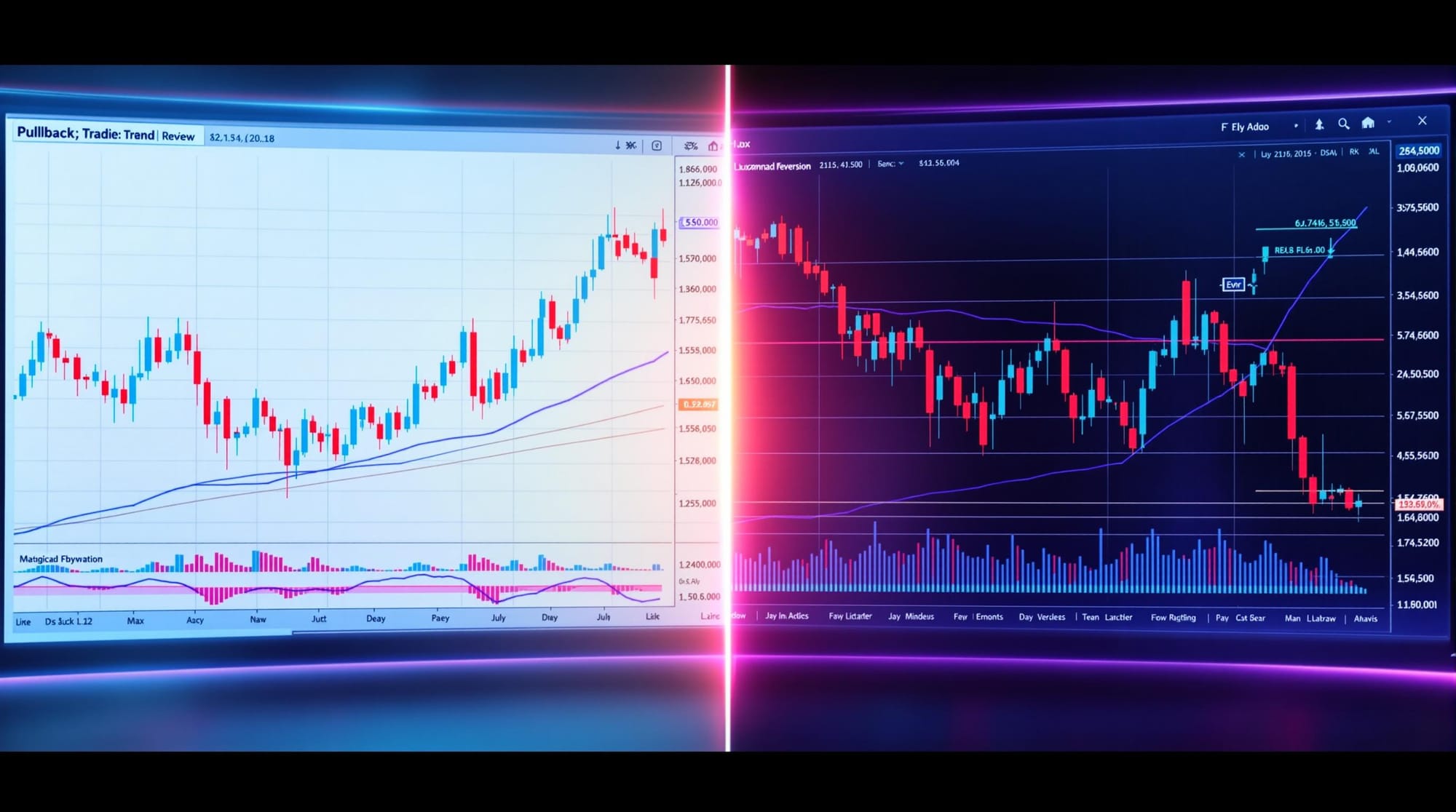Learn to distinguish between pullbacks and trend reversals to enhance your trading strategy and manage risks effectively.
Want to trade smarter? Understanding the difference between pullbacks and trend reversals is crucial. Both involve price moving against a trend, but they require completely different strategies. Here’s what you need to know:
- Pullbacks: Short-term retracements in an ongoing trend. Typically last 3-5 candles, with volume dropping 20-30%. Great for entering trends at better prices.
- Reversals: Permanent trend changes. These break key support/resistance levels, often with a 50%+ spike in volume. Higher risk but higher reward.
Quick Comparison
| Characteristic | Pullback | Reversal |
|---|---|---|
| Duration | 3-5 candles | Weeks/months |
| Volume | Drops 20-30% | Spikes 50%+ |
| Market Structure | Maintains trend patterns | Breaks trend completely |
| Risk/Reward | 1:2-1:3 | 1:3+ |
Key takeaway: Mistaking one for the other can lead to larger losses. Use tools like RSI, moving averages, and volume analysis to spot the difference. Ready to dive deeper? Let’s break it down.
How to Differentiate Between a Pullback and a Reversal
Main Differences: Pullbacks vs Reversals
Price Movement Patterns
Pullbacks are temporary pauses in an ongoing trend. In an uptrend, you'll still see higher highs and higher lows, while in a downtrend, lower highs and lower lows remain intact. These counter-moves usually last about one-third to half the time of the prior trend segment [5].
Reversals, on the other hand, break the existing trend completely. For example, in an uptrend, a reversal is marked by lower lows that breach key support levels. These shifts often form patterns like head-and-shoulders or double tops [4]. To confirm a reversal, traders usually look for validation across multiple timeframes – what appears as a reversal on a daily chart often needs confirmation on a weekly chart [3].
Next, let’s look at how volume behavior sets these two apart.
Volume Characteristics
Volume offers a clear way to differentiate between pullbacks and reversals. Pullbacks are typically accompanied by a noticeable drop in volume – about 20-30% below the trend's average. This signals that the counter-trend move is more about profit-taking than a change in sentiment [5].
Reversals, however, tell a different story. They’re often marked by a sharp spike in volume, especially during breakout moments when price breaks through key support or resistance levels. A valid reversal might see volume surging 150% or more above the average as the pattern completes [5][6]. This kind of volume increase often signals institutional activity driving the new trend.
These volume differences are crucial for making informed decisions about risk.
Risk Setup Differences
The way traders manage risk varies significantly between pullbacks and reversals. In pullback trades, stop-loss orders are set closer to the entry point – typically 1-2% below the entry price in equity markets. These stops are placed just beyond recent swing lows, reflecting the higher likelihood of trend continuation [3][5].
Reversal trading, by contrast, involves wider stop placements, usually 3-5% beyond the pattern’s boundaries. This extra room accounts for the higher volatility during trend transitions, while still allowing for reward ratios of 1:4 or more. Pullback trades, by comparison, usually aim for reward ratios in the range of 1:2 to 1:3 [4][6].
Understanding these differences is key to aligning your strategy with the market's behavior.
How to Spot Pullbacks and Reversals
Using Technical Indicators
Technical indicators can help differentiate between pullbacks and reversals. The Relative Strength Index (RSI) is particularly useful here. In an uptrend, pullbacks often see the RSI dip below 50 [2][6]. However, when the RSI shows bearish divergence – where it makes lower highs while prices hit equal or new highs – it could signal a reversal [4].
Moving averages also play a crucial role. Pullbacks often find support at rising moving averages, especially the 20 EMA [4]. On the other hand, if prices break below key moving averages, like the 200 SMA, and this happens with increased volume, it suggests a potential trend reversal [5].
| Indicator Type | Pullback Signal | Reversal Signal |
|---|---|---|
| RSI | Dips below 50, keeps higher lows | Shows bearish/bullish divergence |
| Moving Averages | Bounces off 20/50 EMA | Breaks below 200 SMA with strong volume |
| Volume | 20-30% below trend average | Spikes to 150%+ above average at breakout |
While indicators provide measurable signals, price action patterns can visually confirm these movements – let's dive into those.
Reading Price Action Signals
Candlestick patterns are a great tool for confirming both pullbacks and reversals. For pullbacks, watch for bullish engulfing patterns or hammer formations near trendline support [4]. These patterns are even more reliable when they occur around Fibonacci retracement levels, such as the 38.2% level [3].
For example, Tesla's March 2024 reversal was marked by an 8% range bearish candle following an extended uptrend [6].
Fibonacci retracement levels also provide clarity:
"GBP/USD reversed trend on April 3, 2024 after breaking the 61.8% retracement with a MACD crossover" [2][6].
Key signs of a valid reversal include:
- Breaking the market structure (as outlined in the Price Movement Patterns section)
- Strong momentum shifts with clear directional moves
- Divergence on momentum indicators
- Alignment with stop-loss strategies from earlier risk management guidelines
For the best results, combine these signals with structural analysis covered in previous sections.
sbb-itb-cf0ed88
Trading Mistakes to Avoid
Pullback Trading Errors
A common issue in pullback trading is entering positions too soon. Many traders mistake temporary price moves for completed pullbacks and jump in before confirming the trend will continue. Research shows that 62% of amateur traders make this mistake, compared to only 22% of experienced professionals [4].
| Pullback Error | Solution |
|---|---|
| Premature Entry | Wait for price to reclaim key Fibonacci levels (38.2%-61.8%). |
| Volume Misreading | Ensure volume patterns align with the trend structure. |
| Position Sizing | Adjust position size based on current volatility. |
These errors often stem from impatience. On the other hand, reversal trading mistakes are usually about misinterpreting confirmation signals. Let’s dive into those.
Reversal Trading Errors
Reversal trading has its own pitfalls, especially with pattern recognition. Many traders act on incomplete technical patterns:
"Aborted double tops/bottoms missing confirmation closes and head-and-shoulders patterns without neckline breaks are common traps that lead to significant losses" [4].
Another big mistake in this area is poor stop-loss management. Moving stop-losses further away when the price moves against you can lead to even larger losses. In fact, proper stop-loss adjustments have been shown to reduce maximum drawdowns by 38% compared to leaving stops static.
General Strategy Risks
All trend-based trading strategies come with broader risks that need attention. For instance, traders often underestimate how fundamental events can disrupt technical setups.
Correlation risk is another blind spot. Many traders fail to account for how related markets can influence their positions. Features available on the LuxAlgo platform, such as advanced volume analysis indicators that pinpoint institutional liquidity zones, can reduce the chances of misinterpreting support and resistance levels.
Finally, emotional mistakes like revenge trading or overtrading to meet quotas can lead to unnecessary losses. Sticking to predefined rules and maintaining discipline – such as adhering to a 1:4 risk/reward ratio – can help keep these behaviors in check.
Picking Your Trading Approach
Main Points Review
Deciding between pullback and reversal strategies comes down to three key factors: your trading style, risk tolerance, and ability to recognize patterns. Pullbacks typically offer a win rate of 55-65% with a risk-to-reward ratio of 1:1.5-2. On the other hand, reversals have a lower win rate of 40-50% but can deliver higher returns with ratios of 1:3 or more [3][6]. These stats should be considered alongside the common mistakes discussed earlier.
Ultimately, the best choice depends on how consistently you can identify the patterns and signals outlined in this article.
| Strategy Aspect | Pullback Trading | Reversal Trading |
|---|---|---|
| Win Rate | 55-65% | 40-50% |
| Hold Time | 3-10 days | Hours-3 days |
| Risk Ratio | 1:1.5-2 | 1:3+ |
| Market Condition | Strong trends | High volatility |
Using the LuxAlgo Platform

To put these strategies into action, specialized features on the LuxAlgo platform can make the process smoother and more accurate. These offerings are designed to address the challenges of identifying patterns, as discussed in the 'How to Spot Pullbacks and Reversals' section.
- Smart Volume Oscillator: Analyzes volume divergence to pinpoint genuine reversals.
- Adaptive Moving Average System: Ideal for spotting pullback opportunities in trending markets [1][3].
- Pattern Recognition Scanner: Automatically detects formations like head-and-shoulders and double tops/bottoms, complete with built-in confirmation checks to minimize errors [4][6].
- Multi-Timeframe Tools: Combine pullback and reversal strategies by confirming signals across different timeframes.
- AI Backtesting Assistant: Helps optimize strategy parameters by analyzing historical performance under varying market conditions.
These features simplify the process, reducing the risk of acting on incomplete or misleading patterns and helping traders align their strategies with market conditions.
FAQs
What is the difference between a retracement and a reversal?
A retracement is a temporary price movement that goes against the current trend, while a reversal signals a complete change in the trend's direction. Here's a quick comparison:
| Characteristic | Retracement | Reversal |
|---|---|---|
| Volume | Below average | 150%+ spike |
| Trend Structure | Maintained | Broken |
These differences are directly tied to the risk management strategies covered earlier.
How to differentiate between reversal and retracement?
Identifying whether a movement is a retracement or a reversal involves several factors:
-
Volume Analysis: Reversals are often accompanied by a significant volume increase, typically over 150% of the average. This is a strong indicator of a trend change.
-
Candlestick Patterns: Look for specific patterns. Retracements usually have small-bodied candles (less than 33% of their range) with long wicks. Reversals, on the other hand, show large engulfing patterns that cover more than 75% of the prior candle's range [3][5].
-
Technical Confirmation: Using features like LuxAlgo's Pattern Recognition Scanner can help confirm potential reversals with multiple indicators.
"Trades using triple confirmation of price action, momentum, and volume show 90% higher success rates than single-indicator strategies." [2][4]
- Market Context: The overall market environment matters. During low volatility periods (e.g., VIX <20), pullbacks are more common and often present better trading opportunities. In contrast, high volatility (e.g., VIX >30) tends to lead to more genuine reversals [3][5].
References
- Oscillator Matrix Reversal Signals
- Support/Resistance Indicator
- Market Structure Concepts
- Relative Strength Index (RSI)
- Pullback vs. Reversal Trading Insights
- Double Tops/Bottoms Patterns
- Trend Reversal Patterns
- Pullback Trading Strategy
- Additional Trend Reversal Patterns
- Reversal Trading Insights
- Candlestick Structure Indicator
- Fibonacci Retracement Levels
- Tesla Investor Relations
- Trend Reversal Strategy Example
- AI Backtesting Assistant Overview
- Reversal Signal Information
- Smart Volume Oscillator






